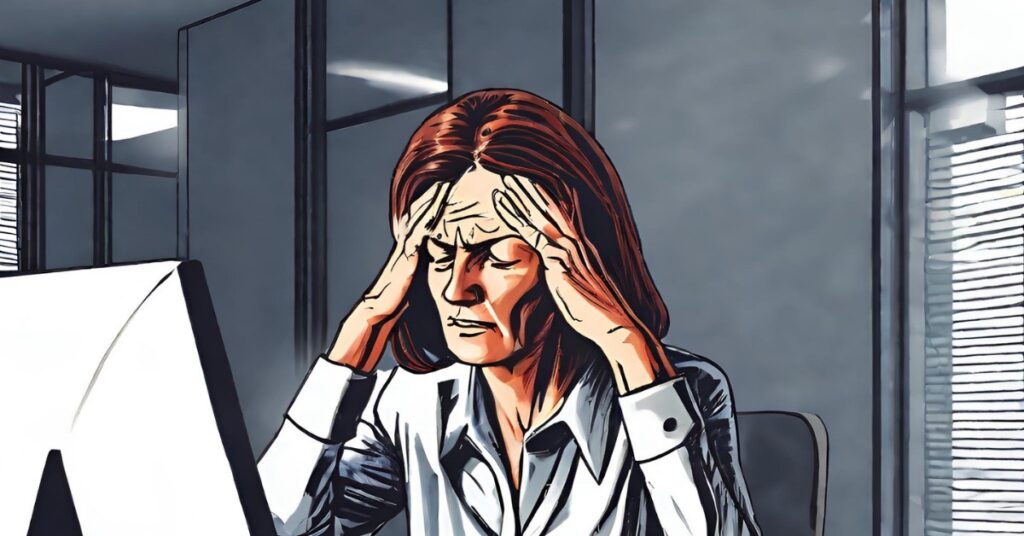It’s been estimated that more than 40% of patients with brain injuries also suffer from light sensitivity. A person who has suffered a severe blow to the head may experience photophobia and other brain injury delayed symptoms weeks, months, or even years after the event. In this guide, Traumatic Brain Injury (TBI) patients will learn how brain injuries cause light sensitivity and how to manage the condition.
Table of Contents
Photophobia: What Is It?
Photophobia is an aversion to light. Where the average person would be comfortable, someone with photophobia may experience severe discomfort. Brain fog and headaches, including migraines, are common among photophobia sufferers.
If a person has PCS (post-concussion syndrome) symptoms like eye strain, blurry vision, or double vision, they’re more likely to have a light sensitivity. Thankfully, TBI symptoms such as concussion-related photophobia can be managed.
Glare Filters For Work Lighting
Light covers that solve lighting headaches & migraines.
While photophobia is a common post traumatic brain injury effect, its symptoms are difficult to distinguish from other long-term effects of brain injury. The most common photophobia symptoms include:
- Discomfort and pain when exposed to interior lighting
- Eye strain and soreness from computer screens
- Fatigue
- Ocular pain
- Migraines and headaches
- An aversion to bright lights
Post-concussion symptoms often include:
- An inability to multitask
- Dizziness or vertigo
- Cognitive fatigue
While photophobia doesn’t always cause these symptoms, they may appear concurrently. After a TBI, the brain may use more energy to process intense light, leaving less for other uses.
Why Does Light Sensitivity Come After a Head Injury?
Unlike other effects of TBI, extreme light sensitivity is typically caused by an injury to the thalamus, a structure located just above the brain stem between the midbrain and cerebral cortex. The thalamus assesses the visual information it receives, delivering nerve signals to other parts of the brain.
The arteries connected to the thalamus may be damaged after a serious head injury, which deprives the structure of the nourishment and oxygen it needs. If the thalamus can’t filter incoming light, the brain may become overstimulated. This is one of the most bothersome effects of traumatic brain injury, as it leads many sufferers to remain in darkened settings with little visual stimulation. However, photophobia is not always caused by thalamic damage; it can also occur after damage to the areas listed below.
- The ANS or autonomic nervous system. The ANS controls most of the body’s autonomic functions, including respiration, blood pressure, pupil dilation, heart rate, and many more. If an ANS disruption occurs, the pupils may become significantly dilated, letting too much light into the eyes and causing sensitivity.
- The superior colliculus. This part of the brain controls the eye muscles and keeps the body oriented in space. If the superior colliculus malfunctions, vision may be affected, and one is more likely to wonder, “do migraines cause brain damage?”
- The vestibular system. The brain uses three different systems to help one understand and detect their position relative to nearby objects: the visual system, the proprioceptor system, and the vestibular system. The visual and vestibular systems may receive conflicting neurological signals after a severe or moderate traumatic brain injury, causing the brain to enhance these signals and leading to photophobia and light sensitivity.
- As a symptom of migraine. Do migraines damage the brain? In certain ways, yes. Chronic migraine may change the way the brain acts and looks with time. And, as most migraine sufferers know, these debilitating headaches come with symptoms such as nausea, sensitivity to sound, and sensitivity to light.
While it’s possible to suffer traumatic brain injury effects years later, most of the symptoms, including light sensitivity, are highly treatable. With the right treatment plan, head injury-related photophobia and migraine pain can be managed, reduced, and potentially eliminated.
Treating Photophobia After a Head Injury
If someone is dealing with traumatic brain injury symptoms long term, sensitivity to light may clear up after a few months. However, with severe traumatic brain injuries, as well as post-concussion syndrome, photophobia may last beyond the expected recovery period. It’s important to work closely with a medical team, as the following treatment methods may reduce light sensitivity and migraine pain after a brain injury.
Vestibular Therapy
If severe light sensitivity comes with dizziness, the problem may lie in the vestibular system. Therefore, addressing the issue may minimize photophobia. It’s possible to reduce one of the most troublesome long-term effects of a mild traumatic brain injury with therapeutic exercises that target balance, visual issues, and motion sickness. Try the following moves to improve the condition of the vestibular system:
- Lie or sit on a bed or sofa. Move the eyes upward and downward, then left and right.
- Slowly bend the neck backward and forward, then left and right.
- Stand up and throw a tennis ball from hand to hand at slightly above eye level.
Some of these movements may lead to feelings of dizziness, so ask someone to observe the process. If the dizziness is too severe, sit down and rest—and consider calling a doctor for an appointment.
Stabilizing the Gaze for Clearer Vision and Less Light Sensitivity
Again, if blurry or double vision is one of the traumatic brain injury long term effects a person is dealing with, it may increase their level of light sensitivity. Vision therapies that strengthen the optical muscles may also work to reduce eye strain. Therapists often use these gaze stabilization techniques to help patients focus on stationary objects while their bodies are moving. Some of the most common gaze stabilization exercises include:
- Looking ahead and focusing on a stationary target while walking toward it, or while getting up from a sitting position
- Nodding the head up and down, then moving it from side to side while remaining focused on a target
It’s best to perform these exercises for 10 to 15 repetitions at first, and to gradually increase that number as the treatment plan progresses. By working their way up slowly, TBI patients can reduce the risk of brain fog headache, dizziness, and motion sickness.
Flavonoids
While medical research is ongoing, flavonoids are believed to be important for eye health and good vision. These plant-based antioxidants work to increase BDNF (brain-derived neurotrophic factor) production, which accelerates the brain’s natural healing processes. As the brain heals, its uptake of sensory information will improve—as will TBI-related light sensitivity.
Flavonoids are found in colorful foods such as:
- Blueberries
- Strawberries
- Cranberries
- Red kale
- Tomatoes
- Carrots
As antioxidant intake increases, brain inflammation will decrease, and photophobia symptoms will diminish. By including more fruits and vegetables in their diet, TBI patients cant boost their flavonoid intake easily and naturally.
Gentle Movements
The latest research shows a link between aerobic exercise and the reduction of photophobia and other brain injury symptoms long term. Other exercise benefits include:
- More blood flow to the brain. During a workout, cardiovascular function is improved and more blood flows to the brain. Overall function is improved, and that may help the brain process light.
- The addition of neurotransmitters. Researchers have discovered that regular exercise increases neurotransmitter numbers. With more neurotransmitters, the brain will process information sooner, including the sensory input from bright lights.
While exercise can be helpful, it’s important not to overdo it. If a movement causes migraine brain fog or other symptoms, rest and try another treatment later.
Fix Your Work Lighting
Light covers that solve lighting headaches & migraines.
Preserve Eyesight
While the other treatments on our list will reduce light sensitivity, they’re not an instant cure. Until treatment results become apparent, it’s important to protect the eyes. Follow these easy tips:
- Wear sunglasses when possible. Wearing shades outdoors will reduce eye strain but remember to take them off when indoors. To recover from photophobia, one must gradually increase their tolerance to light, and wearing sunglasses inside makes the process harder.
- Minimize screen time. If you’ve ever wondered, “What does blue light do to your brain”, it’s a common question among computer users. To reduce light sensitivity when coping with traumatic brain injury effects years later, try to limit the time spent in front of the television, phone, and computer. Otherwise, the blue light emitted by these devices will quickly overstimulate the brain. If one’s work involves screen usage, they should wear light-filtering glasses, which may reduce headaches.
- Try colored glasses. Wearing colored lenses will reduce the level of visual stimuli the eyes receive, which lightens the load on the working brain. As recovery goes on, though, it’s best to rely on colored glasses less frequently.
We’ve saved the most important tip for last: try to improve your sleep habits. The better and longer a person sleeps, the faster the brain heals. To allow the eyes (and brain) to wind down, stop using electronic devices at least 60 minutes before bedtime.
Brain Injuries and Light Sensitivity
What is it like to have a traumatic brain injury? Coping with TBI can bring life-altering effects, with photophobia and light sensitivity being among the most troubling traumatic brain injury eye problems. Though most cases resolve themselves eventually, some patients deal with traumatic brain injury symptoms years later. By understanding the root causes of light sensitivity, you can learn how to manage and treat it without becoming a my brain hurts meme.

